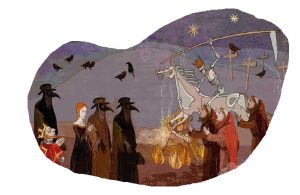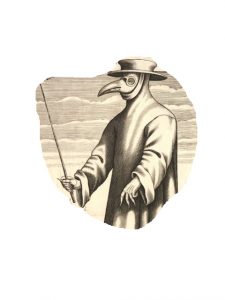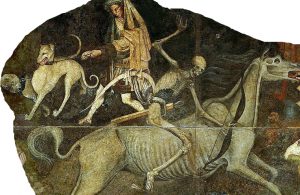



Inside the file 443, in the historical archive of a city, a contract drawn up in 1479 between a young doctor and the public authorities of those places is still preserve today. In exchange for the monthly salary of thirty florins, as well as a comfortably furnished house in the city, Giovanni Ventura had to treat the plague victims of Pavia, limiting himself, however, to those suffering from bubonic plague. He believed that his mask could purify the poisoned air, as well as that the use of special gloves and a large hat could protect him. https://www.focus.it/cultura/storia/il-medico-della-peste.

Within the walls of that city in Lombardy, the man everyone called “the Doctor with the Beak” wore a professional waxed overcoat. During the plague of 1636, doctors in Nijmegen and Venice, Rome and Naples used dress he wore. Approaching him mentally and emotionally to the idea of death, not even the people of Pavia liked the clothing he wore in doing his risky job. In visiting the plague victims, without touching them, Giovanni Ventura used wooden stick and prescribed antidotes. https://www.epicentro.iss.it/territorio/aosta/anziani/09_MALATTIE%20E%20CURE%20DI%20UN%20TEMPO.pdf. 

Of that plague doctor, the use of mask, beak and the strange dress fell into disuse only from the eighteenth century. In Pavia, the doctor with the long beak appeared when he moved to the infected in the places affected by the plague. Giovanni Ventura had no wife or children, he respected the authorities who had granted him citizenship and was of few words with all the plague victims, from whom he did not expect compensation, as he was already salaried by the municipality. Not only. With at least ten days’ notice, he could leave the post. https://www.aboutpharma.com/blog/2021/04/16/la-lunga-storia-delle-mascherine-da-quelle-a-becco-alle-filtranti/
As an extra precaution, his face was cover with a goggle mask, complemented by a beak-shaped cone containing scented essences. Giovanni Ventura did not swear or even use dirty language, and he even refrained from ambiguous answers. Courageous and well manner, he was aware of the danger he ran in having undertaken to behave cordially and compassionately with any plague victim of Pavia. Furthermore, wise and professional in his prognosis, he never disdained collaborating with his colleagues. https://www.amazon.it/Medico-al-tempo-della-peste/dp/889962710X.
Of that plague doctor, the use of mask, beak and the strange dress fell into disuse only from the eighteenth century. In Pavia, the doctor with the long beak compared when he moved to the infected in the places struck by the plague. Giovanni Ventura had no wife or children, he respected the authorities who had granted him citizenship and was of few words with all the plague victims, from whom he did not expect compensation, as he was already salaried by the municipality. Not only. With at least ten days’ notice, he could leave office. https://www.aboutpharma.com/blog/2021/04/16/la-lunga-storia-delle-mascherine-da-quelle-a-becco-alle-filtranti/.
As protection against infection, some of the women in Pavia who had fallen ill with the plague, which Giovanni Ventura touched with his long stick, registered around the neck, had a pierced “pomander” with a spherical shape, often made of gold or silver. With necklines so large as to leave nothing to the imagination, the very elaborate “cipriane” of his patients were close on the front, from the throat to the feet; therefore, he was bound to undo long rows of buttons, often precious, under which the mysterious bacillus spread to the axillary or inguinal lymph nodes. Instead, it was among men that, sometimes containing more perfumes, that fragrant pendant was on his belt. https://www.ilpalio.org/gabrielli_pestetrasmissione.htm.
With shapes, colors and new fabrics, the women he tried to cure manifested social belonging through different clothes, which nevertheless covered the same wounds for all of them, regardless of social class. The dress most worn in every social class, from chivalrous, courteous, or honorable men to donkeys, was a wide skirt from the waist down, which, fastened at the hips by a belt, was worn over undergarments. When entering the homes of the plague victims, the doctor Giovanni Ventura found some dressed also with a long shirt, with a round neckline and narrow sleeves. https://www.panorama.it/news/salute/gli-indumenti-protettive-nei-secoli-dalla-peste-nera-al-coronavirus-storia-e-foto
A Journey Where Wisdom Comes from Listening, Not Speaking The Indigenous Peoples of North America…
Passion and Tragedy in Shakespeare's Verona The desire to escape from the everyday and take…
Provence Trip, Inspiration for All Beauty Lovers "Sometimes you leave to forget, other times to…
When originality feeds on contamination Taking on different meanings depending on the context in which…
The Ermine, a Powerful Symbol Capable of Evoking Deep Meanings in Art and Collective Psychology…
An invitation to rediscover the beauty of the world and the joy of living If…
This website uses cookies.